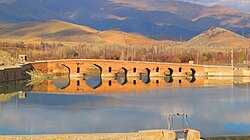This article needs additional citations for verification .(March 2023) |
Shahrestan Bridge Persian: پل شهرستان | |
|---|---|
 | |
| Coordinates | 32°37′37.3″N51°43′3.6″E / 32.627028°N 51.717667°E |
| Crosses | Zayanderud |
| Locale | Isfahan, Iran |
| History | |
| Construction end | 1957 |
| Location | |
 Interactive map of Shahrestan Bridge | |
The Shahrestan bridge is the oldest bridge on the Zayandeh River in Iran. [1] The foundations date back to the Sasanian era (3rd to 7th century C.E.), but the top was renovated twice, first in the 10th century by the Buyids, then during the 11th century during the Seljuk period.
Contents
The bridge consists of two parabolas. The vertical parabola ensures that the middle of the bridge is its highest point. The horizontal parabola produces a bend to the west, strengthening it against the flow of the river. The bridge is 107.8 metres long and an average of 5.2 metres wide. It has two tiers of pointed arches, thirteen large ones spanning the river itself, and eight smaller ones that nest between them. The Zayandeh River has recently been diverted about 100 meters away from the bridge towards the south, leaving an artificial lake around the bridge to protect it from further damage.




